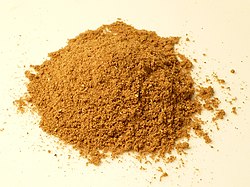Garam masala
From Wikipedia, the free encyclopedia
Garam masala, the literal meaning of which is 'hot spice' (in the meaning of high temperature as opposed to spiciness), is a basic blend of ground spices to be used alone or with other seasonings. It is common in Indian, Bangladeshi and Pakistani cuisines.[1]
Contents |
[edit] Ingredients
Usually the garam masala differs according to region. There are a variety of garam masalas you will find in India. Some common ingredients are black & white peppercorns, cloves, bay leaves, long pepper (also known as pippali), black cumin (known as shahi jeera), cumin seeds, cinnamon, black & brown & green cardamom, nutmeg, mace, and star anise, coriander seeds. Varying combinations of these and other spices are used in regional variants of garam masala.
There are many variants and each one is formulated for a specific purpose.[1] There are numerous ways in which garam masala is prepared in different regions of India. There is no way of determining which of them are more authentic than others. [2]
Some recipes blend spices with herbs. Yet others grind the spices with water, vinegar or other liquids, such as coconut milk, to make a paste. In some recipes nuts, onion or garlic may be added. The flavours may be carefully blended to achieve a balanced effect, or in some cases a single flavour may be emphasized for special dishes where this is desired. Usually a masala is cooked before use to release its flavours and aromas.[1]
[edit] Regional variations
It is generally understood that the spices to be included in a garam masala will vary according to region, and personal choice. The basis of a North-West Indian garam masala usually comprises cloves, green and/or black/brown cardamom, cinnamon (or probably cassia), and mace and/or nutmeg. Black pepper can be added if the mix is to be used immediately, but if kept, the fragrance will diminish, and may change in character. Also typical of the region is the use of black cumin (not white cumin, nor caraway, which is not an Indian spice). [2] The components of the mix are ground together, but not roasted. Garam masala is not 'hot' in the sense that chillies are, but is fairly pungent. Garam refers to the term 'hot' as applied to temperature, whereas the Hindi word teekha (derived from the Sanskrit teekshNa) describes heat as applied to the heat of chillies.
[edit] Commercial mixtures
Many commercial mixtures may include more of other less expensive spices and may contain dried red chili peppers, dried garlic, ginger powder, sesame, mustard seeds, turmeric, coriander, bay leaves, star anise and fennel. While commercial garam masala preparations can be bought ready ground, as with all ground spice, they do not keep well and soon lose their aroma. Whole spices, which keep fresh much longer, can be ground when needed using a mortar and pestle or electric coffee grinder.
Garam masala can be found in two forms: the whole and individual spices purchased separately, or a commercially ground mixture made from the spices. When commercially ground garam masala is used in dishes, it is often added at the end of cooking so that the full aroma is not lost. Whole garam masala, however, is added with the fat/oil/ghee for a more pungent flavour. Because of the deeper flavour, many Pakistani and Indian chefs will not use commercially ground garam masala and insist on making their own from whole spices and herbs. Also, some chefs will use the whole spices in some dishes. These are heated in oil to release their aroma before being combined with food.
[edit] Use in specific dishes
The order in which spices are added to food may be very elaborate in some dishes. In the case of the Kashmiri speciality roghan josh, for example, coriander, ginger and chillies are each ground individually. A garam masala of cloves, cinnamon, cardamom, fennel, mace, cumin, turmeric and nutmeg is separately prepared. The cook tastes the dish carefully to determine the precise moment when the next spice should be added. The order is coriander initially, then the ground ginger, then the garam masala and finally the chillies. [1]
In the chicken dish Murgo Kari (chicken curry) the procedure is also precise. First the chicken is fried and removed from the pan. Onion, garlic and fresh ginger are added to the pan and cooked slowly for 7 to 8 minutes. Next cumin, turmeric, ground coriander, cayenne and fennel are added with water and fried for a minute or so. Next tomato concassé is added with cilantro (fresh coriander), yoghurt and salt. The chicken is returned to the pan and more water is added. Finally some garam masala is sprinkled on top, the pot is tightly covered and the dish cooks another 20 minutes before serving.
[edit] See also
[edit] References
| Wikibooks Cookbook has a recipe/module on |
[edit] External links
- Masala and Curry powders
- Garam masala recipe
- Another garam masala recipe
- Punjabi Garam Masala Recipe - Learn to make Punjabi Garam Masala at home




